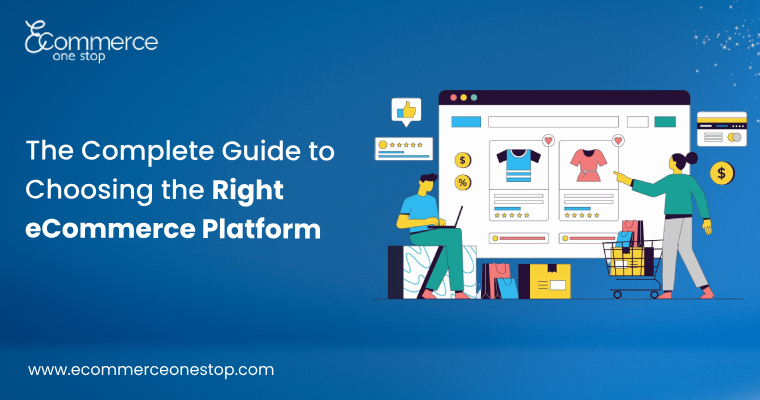The Global Retail E-Commerce Sales Will Reach $6.8 Trillion By 2028 (
Forrester, 2024). As online shopping accounts for 20.5% of total retail sales worldwide (
EMarketer, 2025), selecting the right eCommerce platform is a pivotal decision for businesses.
To navigate this decision of choosing that one platform, you need to understand what sets platforms apart.
In this blog, we’re going to cover everything you need to know about
choosing the right eCommerce platform in 2025. To help you make the right call, we’ll break down key factors, highlight major trends, and compare top platforms shaping the market this year.
Get Your Project Started
Book a free consultation with our Ecommerce experts.
Connect Now

What Are The Key Factors to Consider When Choosing an eCommerce Platform?
Choosing the right platform involves evaluating several critical factors to ensure it meets your business needs:
- Ease of Use: A platform should be intuitive for both you and your customers. A simple interface reduces setup time and improves the shopping experience.
- Customization: Look for platforms that allow you to modify design and functionality to reflect your brand and meet specific requirements.
- Scalability: Your platform must handle increased traffic and sales as your business grows, maintaining performance under pressure.
- Integration: Make sure it’s compatible with tools like payment gateways, marketing automation, and inventory systems for streamlined operations.
- Security: Robust security features, such as data encryption and secure payment processing, protect your customers and business.
- Cost: Evaluate subscription fees, transaction costs, and additional expenses for apps or extensions to fit your budget.
- Support: Access to 24/7 customer support through multiple channels ensures quick resolution of issues.
What Are The Emerging Trends in eCommerce for 2025?
The eCommerce industry is evolving rapidly, driven by new technologies and consumer expectations. Here are key trends shaping the market in 2025:
- Livestream Shopping: Interactive live broadcasts enable real-time purchases, boosting engagement and sales.
- AI-Driven Personalization: AI enhances shopping with personalized recommendations and chatbots. The AI in eCommerce market will grow from $7.25B in 2024 to $64.03B by 2034, at a 24.34% CAGR (Precedence Research, 2024).
- Social Commerce: Platforms like Instagram and TikTok are major sales channels, requiring strong social media integrations.
- Composable Commerce: Modular platforms allow businesses to combine best-of-breed microservices for flexibility and agility.
- Sustainability: Eco-conscious consumers favor platforms supporting sustainable practices, like carbon-neutral shipping.
- Voice Commerce: With growing use of voice assistants, platforms optimized for voice search gain a competitive edge.
- Augmented Reality (AR): AR lets customers visualize products, reducing returns and boosting satisfaction.
- Subscription Models: Subscription-based sales offer convenience, requiring platforms with robust recurring billing features.
- Omnichannel Capabilities: Smooth integration across online, mobile, and physical stores meets modern customer expectations.
- Diverse Payment Options: Support for digital wallets and buy-now-pay-later options enhances checkout convenience.
How These Trends Influence Your Platform Choice?
To stay competitive, your platform must support these trends. Here’s how they impact your decision:
- Livestream Shopping: Choose platforms with built-in livestreaming or integrations with services like TikTok Live.
- AI-Driven Personalization: Opt for platforms offering AI tools or third-party AI integrations for tailored customer experiences.
- Social Commerce: Ensure strong integrations with social media platforms to enable direct sales on Instagram, Facebook, or TikTok.
- Composable Commerce: Select modular platforms that support microservices for customized solutions.
- Sustainability: Look for features that support eco-friendly practices, such as carbon footprint calculators.
- Voice Commerce: Prioritize platforms optimized for voice search and assistant integrations.
- AR Integration: Choose platforms supporting AR tools to enhance product visualization.
- Subscription Models: Ensure robust subscription management, including recurring billing and customer accounts.
- Omnichannel Capabilities: Select platforms that unify online and offline sales channels for a cohesive experience.
- Payment Options: Verify support for diverse payment methods, including digital wallets and emerging options.
By aligning your platform with these trends, you can future-proof your business and meet evolving customer demands.
What Are The Top eCommerce Platforms in 2025?
The best platform depends on your business needs, but here are some leading options in 2025:
- Shopify: User-friendly with a vast app marketplace, ideal for businesses of all sizes.
- WooCommerce: Open-source and WordPress-integrated, offering high customization for tech-savvy users.
- BigCommerce: Scalable with robust features, suited for larger businesses.
- Magento (Adobe Commerce): Powerful for enterprises with complex needs.
- Wix eCommerce: Affordable and design-focused, great for small to medium businesses.
- Squarespace: Known for stunning templates, perfect for visually appealing stores.
Each platform has unique strengths, so evaluate them based on your goals, budget, and technical expertise
| Platform |
Ease
of Use |
Customization |
Scalability |
Key
Features |
Best
For |
| Shopify |
High |
Moderate |
High |
App marketplace, social commerce |
Small to large businesses |
| WooCommerce |
Moderate |
High |
High |
WordPress integration, open-source |
Tech-savvy users |
| BigCommerce |
High |
Moderate |
High |
Scalability, B2B features |
Medium to large businesses |
| Magento |
Low |
High |
High |
Enterprise-grade, complex needs |
Large enterprises |
| Wix eCommerce |
High |
Moderate |
Moderate |
Design-focused, affordable |
Small to medium businesses |
| Squarespace |
High |
Moderate |
Moderate |
Stunning templates, user-friendly |
SVisually appealing stores |
What Are The Common Mistakes to Avoid?
When choosing a platform, avoid focusing solely on cost or popularity. A cheap platform may lack scalability, while a popular one might not suit your specific needs. Instead, prioritize alignment with your business requirements and support for 2025 trends. Testing platforms through free trials can also help you make an informed choice.
Conclusion
Selecting the right eCommerce platform in 2025 is crucial for tapping into the $6.42 trillion market. By focusing on ease of use, customization, scalability, integration, security, cost, and support, you can find a platform that fits your business. Staying ahead of trends like AI personalization, social commerce, and sustainability ensures long-term success.
For tailored solutions, consider partnering with a leading
eCommerce website development company in India. Their expertise can help you build a store that stands out in the competitive digital landscape.
Connect with us today to launch your eCommerce store with confidence!
FAQs
1. What is the most important factor when choosing an eCommerce platform?
The most critical factor depends on your business, but ease of use, scalability, and integration capabilities are often top priorities.
2. How much does it cost to set up an eCommerce store?
Costs vary from a few hundred to thousands of dollars, depending on the platform, customizations, and additional features.
3. Can I switch eCommerce platforms later if I'm not satisfied?
Yes, but switching can be complex and time-consuming. Choosing carefully upfront saves effort.
4. Do I need technical skills to manage an eCommerce platform?
Many platforms are beginner-friendly, but advanced customizations may require technical knowledge.
5. What are the benefits of using an eCommerce website development company?
A development company offers expertise in customization, integration, and optimization, ensuring a high-performing store.



